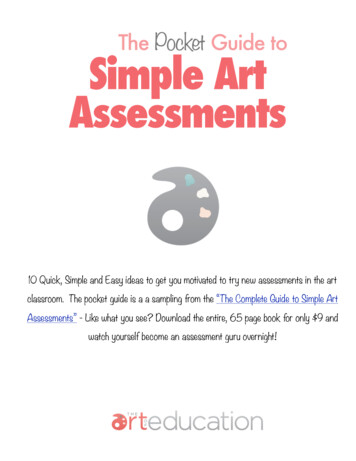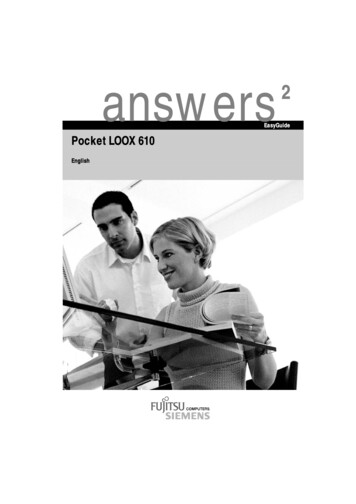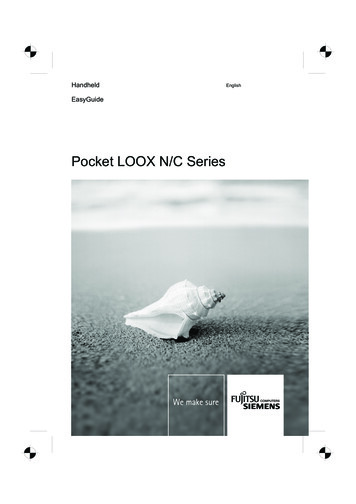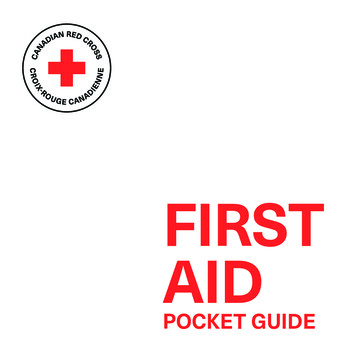
Transcription
The Pocket Guide toSimple ArtAssessments10 Quick, Simple and Easy ideas to get you motivated to try new assessments in the artclassroom. The pocket guide is a a sampling from the “The Complete Guide to Simple ArtAssessments” - Like what you see? Download the entire, 65 page book for only 9 andwatch yourself become an assessment guru overnight!
Feel free to pass along and share this completely FREE E-Book, but please givecredit where credit is due. Always include a link to www.theartofed.com if you sharethis information in any way in print or online.Please note that much of this publication is based on personal experience andanecdotal evidence. Although the author has made every reasonable attempt toachieve complete accuracy of the content in this Guide, they assume noresponsibility for errors or omissions.Copyright 2012 Jessica Balsley, The Art of Education, LLC
About Jessica Balsley.My name is Jessica Balsley, I teach K-5 Art and am a leader in my district as the coordinator andfacilitator of the Art Department. I founded The Art of Education because I was underwhelmed with thequality of resources out there for art teachers, especially the ability to take classes in the field withoutdriving long distances. Because of this frustration, I created AOE which is a unique hybrid of professionaldevelopment opportunities, tips and tricks just for art educators, online graduate level classes, and muchmore. My scope goes beyond simply art education. I am passionate about helping art teachers improve theirlives, work/home balance, teaching strategies, management, professional development, attitudes and athousand other things you won’t find on the average art education blog or website. With this uniquebackground and perspective in art, education and leadership, AOE provides a well rounded perspective onthe manny facets of this profession. Art educators need quality professional development, and I hope toprovide that through the resources found on AOE.Questions or Comments? I’d love to hear from you! Email me at theartofed@gmail.com!
1Verb’s the Word!Using good questioning techniques is important when thinkingabout arts assessment. When asking an assessment question, hereare 4 verbs or starter phrases you can’t live without to ask a goodquestion that gets beyond basic fact recall.Explain“Explain to me how Monet’s brush strokes differ from those ofSeurat”Describe“Describe the process an artist might use to create a coil pot”WhyWhy did you choose to use warm colors in the sky?What if.What if I chose to use zigzag lines instead of straight lines in thiswork? How would it change the meaning of the piece?A detailed tutorial to writing better, higher order assessmentquestions can be found in the “Complete Guide.”
2Wagon WheelsA Wagon Wheel is a formative assessment you can use to helpstudents become more comfortable talking about their artwork,using art vocabulary and build confidence in the art room.Formative assessments should be quick and simple and give youan idea of what your students know in order to inform yourinstruction. I include an entire chapter on formative assessmentswith tons of examples in the “Complete Guide.”Wagon WheelHelp students facilitate feedback to other studentsWhat’s a Wagon Wheel?Arrange students in 2 large circles, one circle inside the other. Eachstudent should have one piece of art in his or her hands.A student on the inside circle lines up with a student on the outside circle. Pairs sharediscussion about their art (facilitated by the teacher) and then the outside wheel rotates,giving students a new partner. Your role during this process is to listen for studentunderstanding through their conversations and gauge where each student is at in thelearning process. This really gets students comfortable talking about their artwork in astructured setting.
3LabelingLabelingUse Sticky Notes to Label art concepts! Have students label where they used warm, cool and neutralcolors using a sticky note directly on their artwork. Arrows ormultiple stickies may help with this. Have students write 3 facts about an artist on a sticky note onthe back of the artwork.You get the idea! The possibilities are endless when it comes touses for sticky notes in the art room.You can check for understanding at the same time you grade theartwork and remove the sticky note after you have graded it.Easy, simple and you can do double duty when grading bothvisual and content related art concepts.I’ve devoted an entire section of the Assessment in Art Education class online for art teachers toFormative Assessments just like this one, where you can create your own and take ideas fromclassmates as well (yes stealing is permitted!)
4Teacher FeedbackTeacher feedback is an important type of assessment - even moreimportant then grading! How have you set up and organizedyour grading in order to have success with the time consumingtask of giving students personalized comments? Even though it cantake you more time to give comments on the back of artwork,research has proven that students are more likely to take apersonalized comment to heart and improve than a simple gradeor letter. To help you, I suggest a pre-formatted template like theone below. Want to download full sheets of blank printables justlike these?.you can find them in the “Complete Guide.”From your teacher. Mrs. BalsleyWOW!! :I can see 5 different values in your still life- great job!Keep working hard at:your craftsmanship - don’t rush
5Student Self-Reflection2 Stars and a WishThe “2 Stars” are things you are proud of about your artwork. Thewish is something you “Wish” you could improve upon or a goal fornext time.2 Stars and a WishMy painting was very neat andtidy!I used warm colors in thesky to make the sunset.I wish I had spent more timeon the details in the boat.Download the entire blank template of this assessment in the “Complete Guide” and put it to immediate use in your classroom
6Make a ChecklistName 3 artists you learned about. Tell me more about them!What process did you use to create this piece?If you could do this again, what would you change?You can use checklists for just about anything in the art roomwhen it comes to assessment. This checklist can help studentsreflect on their own art work or help parents facilitate artconversations with students. Checklists can help studentsorganize their portfolios or even help you grade artworkinstead of a rubric. I like checklists because they are simplebut effective in getting the job done! And doesn’t it feel goodto check something off a list? Sure does!
7Short AnswerIf you don’t have time for a large performance based assessment,Short Answer is a great alternative. It allows you to get inside thehead of the student and understand their thinking and knowledgeof the concepts. It also allows students to use interdisciplinaryconnections to literacy in order to express themselves throughwriting and art. There are two more types of assessment questionsbesides short answer I think are really important. I will go intogreat detail in the Assessment in Art Education class giving youTONS of samples to take with you as you form your own amazingassessment plan for your students.Explain the process an artist might use to create a 6hue color wheel, starting with the 3 primary colors.
8LabelingIn the box below make a quick sketch of your clayproject. Please label using arrows where you willuse the the slip and score method to attach the claytogether.Labeling is a great technique because it’s visual. I especially like labeling as studentsare planning their artwork. This will show you, the teacher, students are ready for theart concept and understand the foundational material before they start to work.Hopefully it will make the creation process much more smoothly.
9Portfolio As AdvocacyHave you ever thought of using a Portfolio not only to assessstudent work, but as an advocacy tool for parent/teacherconnections? When you send home portfolios think of includingthe following with the artwork: Checklists to show the contents of the portfolio to help parentsbetter understand what was achieved in the art room Parent questionnaire to be sent back with the student Teacher feedback forms to parents can see what students aredoing well and needing improvement on. Student self-reflections - Great conversation starters Information about an upcoming art show or art event Links to your website or blog to help parents promote the artprogram
10Make a PlanDo you plan out your assessments throughout the year and makesure you are consistent, or do you just fly by the seat of yourpants?If teachers spent as much time planning out their assessments asthey did their curriculum, assessment wouldn’t be such as sorearea for most teachers. I would suggest using a planning matrixor grid to help you plan out when you will do assessments at eachgrade level. Think about starting with one new assessment foreach class you teach. See how they go, and revise from there. Wecan't do it all, but by taking little bits and chunks we can graduallybecome more comfortable with incorporating assessments into ourdaily teaching.Don’t forget to include: Formative Assessments Summative Assessments Portfolios Self Reflections Teacher Feedback Grading Rubrics and Checklists. the list goes on!Want to make an entire assessment toolkit for your classroom and get graduate credit to do so? Takethe Assessment in Art Education class through AOE and walk out with not only your own toolkit andassessment plan but download the plans of your classmates.
Additional ResourcesCan’t get enough Assessment?If you found the information in this book helpful, take a look atsome other additional FREE resources from myself and others thatcan help to round out your Assessment knowledge. Enjoy!Ultimate Art Assessment PDFI created this document to aggregate content from all over thecountry reviewing the best art assessments and programs around.It’s the most comprehensive resource out there for quality artassessment samples being put to use today and best of all, it’sFREE! View the original post and download right here.Check out these Assessment Blog Posts from AOE:I’ve got you Covered!Assessment ResourcesColor Sort Game: Formative AssessmentTop 10 Reasons Art Assessment MattersVisual RubricTake a Class: Running several times a year “Assessment in ArtEducation” is an online course where you will create assessmentsfor your own classroom, earn graduate credit, and connect with arteducators from all around the country! Sign up, pay, and reserveyour spot today, it only takes a few minutes.
driving long distances. Because of this frustration, I created AOE which is a unique hybrid of professional development opportunities, tips and tricks just for art educators, online graduate level classes, and much more. My scope goes beyond simply art education. I am passionate about helping art teachers improve their










